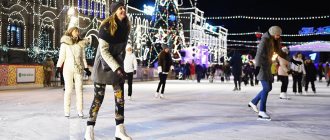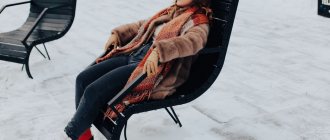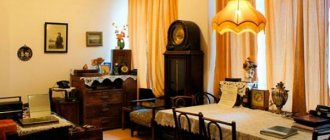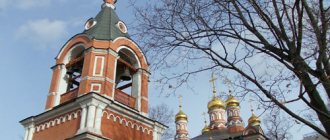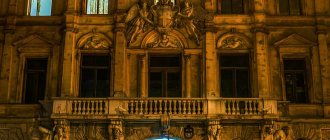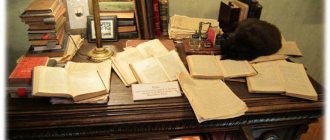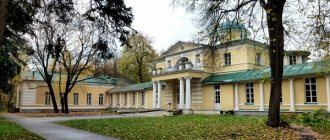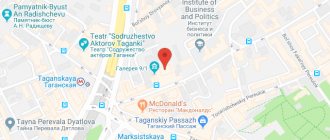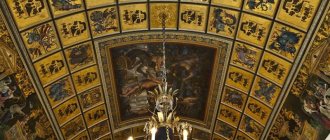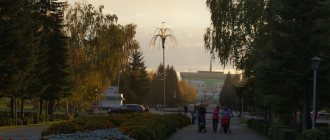"A city to remember." 323. Prechistenka: from Tsereteli to the Garden Ring
May 13, 2021 Photo project “City in Memory”. 323. Prechistenka: from Tsereteli to the Garden Ring
Before the revolution, the inhabitants of Prechistenka were dominated by the nobility and wealthy merchants; during the Soviet years, new houses were built for the Council of Ministers and employees of the competent authorities. The current Prechistenka confirms its elite status by attracting modern aristocracy and gossip column characters to receptions.
Prechistenka, No. 19 - the house of Prince A. Dolgorukov, built in the 1780s, presumably by Matvey Kazakov. Initially, the central part of the palace with a strict large portico, topped with a belvedere with a dome, was connected to side wings, columned galleries on the arcades - a composition unique for the urban estates of Moscow. The facades of the outbuildings had windows and balconies on figured brackets (preserved). In the courtyard there was a semicircular building of services.
In 1812, the house burned down and was rebuilt until 1847. The belvedere disappeared, the through arches leading to the courtyard were blocked. Eclectic decor appeared on the side wings. In 1869, the services in the courtyard were dismantled and two three-story buildings were added for an educational institution that fit into the house. In 1863, the house housed an institution for orphan girls, the Alexander-Mariinsky Women's School, founded by the “cavalry lady” General Chertova and later transformed into the Alexander-Mariinsky Institute of Noble Maidens.
See old photos: Alexander-Marinsky Institute. Sewing workshop. 1905-1911: https://pastvu.com/p/37255
Institute girls received the education of primary school teachers and home educators - who had completed a general course of training, and teachers - who had completed a full course of training. During the Soviet years, the building came under the jurisdiction of the Ministry of Defense. Now it is a museum and exhibition complex of the Russian Academy of Arts “Zurab Tsereteli Art Gallery”.
These days, the mansion hosts fashion shows, exhibitions, and presentations.
Valentin Yudashkin
Vyacheslav Zaitsev and Elena Kondulainen
Mikhalkov family
Prechistenka, No. 21 - a city estate, established in the 1810s, at different times belonged to General A. Tuchkov and Count S. Potemkin. In 1899, the estate was bought by a representative of the famous merchant family I. Morozov, who organized an art gallery in the house. In 1905, the building was reconstructed (architect L. Kekushev) to accommodate the collection. In 1928, the State Museum of New Western Art was organized in the Morozov house, combining the Shchukin and Morozov collections. Since 1948, the Presidium of the Academy of Arts has been located here.
Prechistenka, No. 23 - a modern building (2010) on the site of the city estate of A. Tatishchev-A. Lopukhin, from which only the historical facade was left
Prechistenka, No. 24 - apartment building (1904, architect S. Kulagin) appears in Bulgakov’s novel “Heart of a Dog” as the “Kalabukhov house”. Before the revolution, the writer’s uncle Nikolai Pokrovsky, a well-known gynecologist in Moscow, who became one of the prototypes of Professor Preobrazhensky, lived here. His apartment turned out to be the first Moscow refuge of the young Bulgakov: in 1916, he came here with his wife to stay for a week.
Prechistenka, No. 25 - apartment building N. Ulich (1911-1912, architect V. Rudanovsky)
Prechistenka, No. 26 - residential building (1926)
Prechistenka, No. 27 - apartment building of A. Polovinkin (1910-1911, architect V. Kildishev)
Prechistenka, No. 28 - a residential building with 20 apartments was built in 1904-1906 according to the design of Lev Kekushev for the Moscow Trade and Construction Joint Stock Company. In 1906 it was sold to the St. Petersburg merchant I. Isakov.
Prechistenka, No. 29 - apartment building (1910, architect A. Ostrogradsky)
Prechistenka, No. 30 - apartment building (1968), built for the Council of Ministers of the USSR
The bronze monument to the artist Vasily Surikov was opened in 2003 (sculptor Mikhail Pereyaslavets, architect Anatoly Semenov). Among Surikov’s most famous paintings are “The Morning of the Streltsy Execution”, “Boyaryna Morozova”, “Menshikov in Berezovo”, “The Conquest of Siberia by Ermak”, “Suvorov’s Crossing of the Alps”.
Prechistenka, No. 31 - residential building for law enforcement officers (1935-1937, architect Z. Rosenfeld).
See old photographs: Until 1933, on the site of the house for policemen, there was the Church of the Life-Giving Trinity in Zubov. 1881: https://pastvu.com/p/8436
See old photos: Currency store "Beryozka". 1990: https://pastvu.com/p/416489
Prechistenka, No. 32 building 1 - city estate of the Okhotnikovs. In 1868-1917, the private men's gymnasium of the teacher and public figure L. Polivanov was located here. Currently, the building of the former main house of the estate houses Children's Music School No. 11 named after V.I. Muradeli and Children's Art School No. 1 named after Serov.
In the courtyard is the city estate of the Stepanovs “with circumference” (19th century)
Sudden spring snow May 12, 2021
Prechistenka, No. 33 building 2 - residential building of Pavel Golokhvastov with cellars (1782-1785)
Prechistenka, No. 34 - residential building (1929)
Prechistenka, No. 35 building 1 - the main house of the city estate of the court councilor Pyotr Samsonov, a wooden building erected in 1819 on stone basements of the 18th century. The ensemble is complemented by the left stone wing, built in 1836, and the entrance gate. The decoration of the facade was partially changed in the second half of the 19th century, when moldings of the architraves, cornice rods and, possibly, a rich ornamental frieze of the portico were added.
Prechistenka, No. 35 building 5 - western wing of the city estate of P. Samsonov (1879)
Prechistenka, No. 36 building 1 - modern building, reconstruction of an old mansion
See old photos: Kropotkinskaya street, 36. 1982-1985: https://pastvu.com/p/97579
Prechistenka, No. 36 building 2 - the residential building belonged to Major General Mikhail Naumov and Princess Natalya Volkonskaya. Built in 1833, rebuilt into an apartment building in 1897. Since 1926, children's library No. 13 named after N.K. Krupskaya has been located here, since the late 1960s - the workshop of the restorer Savva Yamshchikov.
See old photographs: Kropotkinskaya street, 36. 1950-1970s: https://pastvu.com/p/363795
Prechistenka, No. 38 - modern building of the Biotechnika Research Institute. In 1894, a three-story stone residential building was built here (architect I. Meisner), which before the revolution belonged to the Russian Society for Insurance of Capital and Income “Life”. In 1988-1990, the house was dismantled due to its emergency condition and a new building was erected in its place.
See old photographs: Kropotkinskaya street, 38. 1930-1939: https://pastvu.com/p/360393
Prechistenka, No. 39 - Likhutin apartment building. The first stage, facing Prechistenka, was built in 1892 according to the design of the architect A. Ostrogradsky, and the part facing Zubovsky Boulevard was built in 1913 according to the design of the architect I. Kuznetsov. From the 1950s until 1991, the building was occupied by the Ministry of Light Industry of the RSFSR.
See old photographs: Kropotkinskaya street, 39. 1930-1933: https://pastvu.com/p/36415 Pay attention to the building on the right, standing across the Garden Ring. In 1935, the expansion of the roadway of the ring will begin and similar obstacles will be demolished.
Prechistenka, No. 40 - apartment building of A. Kunin-L. Matveevsky (1903-1904, architect F. Kolbe). In the 2000s, during the reconstruction process, the house almost doubled in size.
See old photographs: Apartment building of A. Kunin-L. Matveevsky. Beginning of the twentieth century: https://pastvu.com/p/31123
Find out more: https://www.peshegrad.ru/articles/moskovskij_sen_zhermen_velikolepnaya_prechistenka https://trassa.narod.ru/moscow/prechistenka/prechistenka.htm
Photos: Evgeny Chesnokov
In the next story - Manezhnaya Square...
All photo stories of the “City in Memory” project:
Category: Personal blogs. Label: Moscow.
Other publications
11/23/2020 at 11:28 am
Life in the red zone
Everyday life of the Covid hospital at VDNKh.
09/08/2020 at 00:30
Closing day of the 33rd Moscow International Book Fair at Manege
The RB correspondent shares photos and accompanies them with a convulsive reflection from the last day of the MIBF
08/12/2020 at 16:05
VDNKh celebrated its birthday
After several months of online events, entertainment has returned to VDNH.
08/12/2020 at 15:55
Bike patrol will help speed up the registration of road accidents
In Moscow, a bicycle patrol has begun work on Lesnaya Street and inside the Boulevard Ring.
07/22/2020 at 22:56
Dangerous Pizza
The courier's bag paralyzed traffic in the center of Moscow and caused trouble for the security services.
Our correspondent reports. 06/29/2020 at 15:04
#STAYONTHE STREET
Just a month ago we were sitting at home under the slogan #stayhome.
But there are people whose home is the street. Where should they go? 06.26.2020 at 11:24
"Russian blogger" walked near the parade
Ceremonial and non-ceremonial impressions of our correspondents
06/08/2020 at 19:40
How Muscovites walked according to schedule
From June 1, Muscovites were allowed to walk on the street, but not everyone at once and not everywhere.
06.06.2020 at 20:57
Vysoko-Petrovsky Monastery opened its doors to parishioners
The Vysoko-Petrovsky Monastery in the center of Moscow has again become accessible to believers.
06/01/2020 at 20:37
Electric trains are ready for summer
Over 450 electric trains will be prepared for the summer passenger campaign.
05/15/2020 at 16:25
Kursky Station was disinfected again in Moscow
On May 15, employees of the Ministry of Emergency Situations carried out repeated disinfection of the Kursky railway station.
05/01/2020 at 16:07
Going to the store is the main trip of April
April 2021, apparently, became the most disastrous month in the history of tourism - cities and regions were closed, borders were locked.
04/15/2020 at 08:09
Muscovites dream of living an ordinary life
In Moscow, despite the increase in the number of coronavirus cases and the introduction of QR codes for movement, the index of self-isolation of the population is decreasing.
04/14/2020 at 13:03
Moscow in quarantine
Due to the pandemic, a self-isolation regime has been introduced in the city.
24.11.2019 at 16:39
Ice skating season has opened in Moscow
In Moscow, skating rinks have opened in city parks.
On November 22, the main skating rink of the country at VDNH was inaugurated. Evgeny Chesnokov 11/20/2019 at 03:47
"A city to remember." 523. Yauza. Rostokinsky aqueduct - Yauza platform
The main attraction of Rostokino is the aqueduct of the Mytishchi water supply system, built in 1783-1784.
Wait. Add the book to the cart.
“To Obukhov? Do me a favor. We know this lane very well. Here? With pleasure... Eh, no, excuse me. No. There's a doorman here. And there is nothing worse than this in the world. Many times more dangerous than a janitor. Absolutely hateful breed. Nasty cats. Flayer in braid."
Reflections of a homeless dog... This is a quote from “The Heart of a Dog” by Mikhail Bulgakov. “Important dog benefactor,” important Mr. Philip Philipich invites a stray dog to visit.
“The streetlights were taken down all over Prechistenka. His side hurt unbearably, but Sharik at times forgot about it, absorbed in one thought - how not to lose the wonderful vision in the fur coat in the commotion and somehow express his love and devotion to him. And seven times along Prechistenka to Obukhov Lane he expressed it. He kissed the boot near Dead Lane, clearing the way...”
We first reached Dead Lane, which means we were walking along Prechistenka from the center to Zubovskaya Square (Dead Lane is the old name of Prechistensky Lane.) I’m even sure that they - the dog and the important Mr. Philip Philipovich - are walking along the side where the Prechistenskaya police station stood and Moscow Fire Station (Prechistenka St., 22). Serious organizations are still located in this house today: the Main Directorate of the Ministry of Emergency Situations of Russia, the Main Directorate for Civil Defense, the Department of State Fire Supervision... But the fire tower is no longer there: it was demolished a long time ago.
“Some kind of bastard, Siberian-looking stray cat emerged from behind a drainpipe and, despite the blizzard, smelled the Krakow one. The ball of light did not see the thought that the rich eccentric, picking up wounded dogs in the gateway, would take this thief with him, and he would have to share the Mosselprom product “Krakow sausage”. - A.P.>. Therefore, he clanged his teeth at the cat so much that with a hiss similar to the hiss of a leaky hose, he climbed up the pipe to the second floor. - F-r-r... g... y! Out! Mosselprom can’t get enough of all the trash hanging around Prechistenka.”
I also love hanging around Prechistenka: here the shadows of the past come to life in my imagination...
Here is Obukhov (today it is Chisty Lane) - turn right from Prechistenka. Philip Philipovich and the dog enter the first house on the corner. “On the marble platform there was a whiff of warmth from the pipes, they turned it again and here was the mezzanine.” What is a mezzanine? Today we all do not leave the library (from the Internet), it is not difficult to find information at this very hour: “The mezzanine is the second from the bottom, after the ground floor, the floor of the building on which the main halls and rooms are located. On the facade, as a rule, it is distinguished by its height, window sizes, and decorative design. A main staircase located in the interior or outside of the building can lead to the mezzanine.” Philip Philipovich lives well. A very solid little house. But…
“- Was it you who moved into Fyodor Pavlovich Sablin’s apartment? <Sablin - according to Preobrazhensky’s definition, “bourgeois”. - A.P.>
“Us,” Shvonder answered.
- God, the Kalabukhov house has disappeared! - Philip Philipovich exclaimed in despair and clasped his hands.
“Why are you laughing, professor?”
“House of Professor F.F. Preobrazhensky". Corner of Prechistenka and Chisty Lane 24/1 /We are standing on Prechistenka, and Chisty Lane goes ahead from us/
"Kalabukhovsky House"? Mikhail Bulgakov, as usual, “encrypts”, changes surnames, first names, street names... This does not mean some Kalabukhin, but Semyon Fedorovich Kulagin (1867–1953), restorer, architect. The “Kulaginsky” house, where Philip Philipich brought the dog, was built in 1904. Before the revolution, Mikhail Bulgakov’s uncle, gynecologist Nikolai Mikhailovich Pokrovsky, lived here in this house, who served as the writer’s prototype for Professor F.F. Preobrazhensky. This is the house from where, in the spring of 1917, the galoshes disappeared! (Why in the spring and not in the fall? After the “February Revolution”? Even then?.. Doesn’t Bulgakov want to hint at October? - A.P.). The indignant monologue of Professor Preobrazhensky is very revealing (and after all, we have already entered this house and can overhear):
“I have lived in this house since 1903. And so, during this time, until March 1917, there was not a single case - I emphasize in red pencil: not a single one - that at least one pair of galoshes would disappear from our front door downstairs with the common door unlocked. Please note, there are 12 apartments here, I have a reception. In March 17, one fine day, all the galoshes disappeared, including two pairs of mine, 3 sticks, a coat and the doorman’s samovar. And since then the galosh stand has ceased to exist. Darling! I'm not even talking about steam heating. I do not speak. Let it be: since there is a social revolution, there is no need to drown it. But I ask: why, when this whole story began, did everyone start walking up the marble stairs in dirty galoshes and felt boots? Why do galoshes still need to be locked? And also to assign a soldier to them so that someone doesn’t steal them? Why was the carpet removed from the main staircase? Does Karl Marx prohibit carpets on stairs? Is it said somewhere in Karl Marx that the 2nd entrance of the Kalabukhov house on Prechistenka should be boarded up and walked around through the back yard? Who needs it? Why can’t the proletarian leave his galoshes downstairs, but dirty the marble?”
And further:
“Why the hell did they remove the flowers from the sites? Why does electricity, which, God forbid, went out twice over the course of 20 years, now neatly goes out once a month?”
Here they are, details of the “former life”, generously scattered by the master’s hand throughout the text: a marble staircase, a carpet on the main staircase, a shoe stand, flowers (in pots, probably) in the entrance, a samovar at the doorman... Bulgakov sees this house quite clearly from the inside - so the same as we clearly see it from the outside today (the house still stands!). Has Mikhail Afanasyevich been to this house (corner of Prechistenka and Chisty Lane, 24/1)? Certainly! After all, his uncle lived here, gynecologist Nikolai Mikhailovich Pokrovsky (and in the story “Heart of a Dog” this is Professor Philip Philipovich Preobrazhensky).
But before we continue, let’s admire the doctor’s apartment a little more (“a dirty apartment, but what a good thing!” the stray dog Sharik will say very soon) and take a closer look at some of the inhabitants of this house.
“The unknown gentleman, who dragged the dog to the door of his luxurious apartment located on the mezzanine, rang the bell, and the dog immediately looked up at a large, black card with gold letters hanging on the side of the wide door, glazed with wavy and pink glass.”
“The door swung open completely silently, and a young beautiful woman in a white apron and a lace headdress appeared before the dog and his master.”
(This is Zinaida Prokofyevna Bunina - the “social servant” of Professor Preobrazhensky, or, simply put, an assistant to a doctor who works from home.)
“A great variety of objects piled up the rich hallway. I immediately remembered the mirror reaching to the floor, which immediately reflected the second worn and torn Sharik, terrible deer antlers in the height, countless fur coats and galoshes and an opal tulip with electricity under the ceiling.”
Opal tulip under the ceiling... Apparently, a chandelier?
“Upon taking off his fur coat, he found himself in a black suit of English cloth, and on his stomach a gold chain sparkled joyfully and dimly.”
“The two of them found themselves in a narrow, dimly lit corridor, passed one lacquered door...”
(It’s interesting to read into the details when you know exactly where it is on the map of Moscow.)
And here is the professor's office:
“...it was all ablaze with light: it was burning under the stucco ceiling, it was burning on the table, it was burning on the wall, in the glass of the cabinets. The light flooded a whole abyss of objects, of which the most interesting was a huge owl sitting on a branch on the wall.”
“It’s no use for you, gentlemen, to walk around without galoshes in this weather,” Philip Philipovich interrupted him admonishingly, “firstly, you’ll catch a cold, and, secondly, you left a stain on my carpets, and all my carpets are Persian.”
Rich master Philip Philipovich...
“I live and work alone in seven rooms, and I would like to have an eighth. I need it for my library. <…> I have a reception room - mind you - it’s also a library, a dining room, my office - 3. An examination room - 4. An operating room - 5. My bedroom - 6 and a servant’s room - 7.”
This is how a successful doctor in Moscow should live!
The pride of a person who does something and receives a worthy reward for it:
“It is very possible that Isadora Duncan is doing just that. Maybe she's having lunch in her office and cutting up rabbits in the bathroom. May be. But I’m not Isadora Duncan!..”
They say, what do we need your vulgar showbiz?!
I guess that I have already tired my reader with quotes, but, having apologized many times, I will give a few more. Because we have reached my favorite chapter 3 of this story: Philip Philipovich is having lunch!
“On plates painted with heavenly flowers with a wide black border, thin slices of salmon and pickled eels lay. On a heavy board there is a piece of cheese with a tear, and in a silver bowl lined with snow there is caviar. Between the plates there are several thin glasses and three crystal decanters with multi-colored vodkas. All these items were placed on a small marble table, comfortably attached to a huge carved oak sideboard, spewing beams of glass and silver light. In the middle of the room is a table as heavy as a tomb, covered with a white tablecloth, and on it are two cutlery, napkins folded in the shape of papal tiaras, and three dark bottles.”
I re-read this regularly.
Here Zina brings a dish into the dining room... Bulgakov writes:
“Zina brought in a silver covered dish in which something was grumbling. The smell from the dish was such that the dog’s mouth immediately filled with liquid saliva. "Gardens of Babylon"! - he thought and tapped the parquet with his tail like a stick.”
Salmon, eels, multi-colored vodka, napkins, something “grumbling” in the dish, the owner “picked up something like a small dark loaf of bread on a clawed silver fork”... The doctor sat down to have a snack... He gave the dog a bite from his fork, and then “ threw the fork into the rinse rack with a crash”... The rinse rack!
How do you like this: “...only landowners who were undercut by the Bolsheviks eat cold appetizers and soup. A more or less self-respecting person handles hot snacks”? This should be written somewhere on the wall in... well, where do you usually eat, gentlemen?
But let's return from the fairy tale to everyday life. When did Bulgakov visit this house? Let us turn to L. Parshin’s book “Devilry at the American Embassy in Moscow, or 13 mysteries of Mikhail Bulgakov” (Moscow: Knizhnaya Palata, 1991). In the chapter “City of the Master” it is written: “... the beginning of Chistoye, building 1. Mikhail Afanasyevich’s uncle, Nikolai Mikhailovich Pokrovsky, lived here in apartment 12. Even two uncles, also Mikhail Mikhailovich Pokrovsky, though not always. Both are doctors, the first is a gynecologist, the second is a therapist. Bulgakov and his wife Tatyana Nikolaevna visited here a thousand times, both before moving to Moscow and after. A wonderful apartment in the former possession of the famous architectural artist Kalugin. I would even say a luxurious apartment. Six rooms, all white observation, exquisite furniture..."
Chisty Lane, 6. Apartment building A. von Meck
The apartment is luxurious, but the entrance is very shabby... The paws of the cynical chatterbox Shvonder have finally reached the house... Remembering that M. Bulgakov wrote his story in the 1920s, Leonid Parshin quotes document No. 2761 of the Department of Improvement of the MKHU dated September 16 1922:
“In the property No. 26 on Kropotkina Street (formerly Prechistenka), only parts of the stone walls remained from the plundered house; the masonry of the 2nd floor under the resulting span threatens to fall and could cause injury or death to persons who accidentally entered this property and therefore must be dismantled or measures have been taken to maintain it, especially since part of it has already collapsed.”
L. Parshin believes that Bulgakov describes a completely different entrance in the story - with mirrors, flowers on the landing, with a marble staircase... The author believes that Mikhail Bulgakov could have seen such an entrance in another house on Chisty Lane - in house No. 6 (two hundred meters walk from "Professor Preobrazhensky's house"). This is the former “apartment house of A.K. von Meck." The building was built in 1913, architect A. N. Zeligson. Built by order of Alexander von Meck, entrepreneur, famous collector and founder of the Russian Mining Society. A. von Meck was the son of Nadezhda Filaretovna von Meck, patroness of P.I. Tchaikovsky.
L. Parshin writes:
“I rise, as the text of “Heart of a Dog” indicates, to the mezzanine, turn... The door. It has the number 22 and a sign: “Yakov Efimovich Shapiro.” Behind her is a secret. I'm calling.
— Hello, have you read “Heart of a Dog”?
- But of course! Come in!
- Here, you see, such a story...
- Everything is correct, Bulgakov was here... Luck again? Or something else?
Yakov Efimovich was a famous dentist, says the owner of the apartment, surgeon Rina Markovna Breitman. He performed a very responsible job (meaning the Kremlin). Many celebrities were treated at his home: Gorky, Babel, Maretskaya... Mikhail Afanasyevich was also treated here.”
Gynecologist Nikolai Mikhailovich Pokrovsky, uncle of M. Bulgakov
Moscow doctors Nikolai Mikhailovich Pokrovsky (gynecologist) and Mikhail Mikhailovich Pokrovsky (therapist) often came to see their sister Varvara in Kyiv (to see M. Bulgakov’s mother). They loved their sister and her children very much. Both doctors did not have their own children. Bulgakov’s first wife Tatyana Lappa recalls: “He <Mikhail Bulgakov> had just graduated from high school, and Uncle Kolya gave him 25 rubles.” These were just those days when Tatyana (Tasya)’s relatives suddenly did not let Tatyana (Tasya) go to Mikhail from Saratov to Kyiv, and then a telegram arrived from Kiev (!): “Mikhail is shooting himself...” The telegram was sent by Bulgakov’s friend, Alexander Gdeshinsky. The high school students, as always, were overly emotional...
Tatyana Nikolaevna Lappa (Kiselgof), Bulgakov’s first wife, lived until 1982, and L. Parshin managed to interview her in detail in Tuapse. T. Lappa-Kiselgof recalls September 1916 (Bulgakov was already a certified doctor): “... he was called to Moscow for a new appointment, and we went there.” (By the way, other sources claim that Bulgakov first came to Moscow in December 1917...)
T. Lappa recalls: “Oh, Moscow was such a village back then! We went to the theater there, to Maly... Then it rained all the time in Moscow. It seems they were still in “Prague…” We stopped at “Uncle Kolya” (Pokrovsky).
“...we spent very little time there <in Moscow>. A day or two. We lived with an uncle in Obukhov Lane. Mikhail received an appointment to go as a doctor to the zemstvo, and we went to Smolensk. We spent the night there, and then went to Sychevka. There he needed to go to the Zemstvo Council, to the chief. He was a very interesting man. And from there we went to Nikolskoye.”
And then Mikhail Afanasyevich will write a series of stories “Notes of a Young Doctor” (1925). Including the story “Morphine”... In the outback of Smolensk, Bulgakov became a drug addict. We won’t talk about this “by the way,” but again we’ll give the floor to Tatyana Lappa (she also once had to try morphine):
“But the morphine made me dizzy, and I fell somewhere, then fell asleep. And I woke up and started vomiting. So morphine has a disgusting effect on me. Here, the same thing, we tried to snort cocaine... in 1913. I felt disgusting after that. Not just some kind of excitement, but drowsiness. And the vomiting began. And he is great. The ether worked well for me. I went from Nikolskoye to Moscow to see his uncle (we were supposed to have a child, but I didn’t want to), so he then: “What are you, a morphine addict?” I say: “No, Uncle Kolya, in childhood, when I get migraines, I anoint myself with ether and fall asleep.” He says: “You can become an ethereal addict this way. Where is Mikhail looking?
Apartment plan N.M. Pokrovsky in Chisty (Obukhov) Lane /From the book by L. Parshin/
Fragment of an interview with L. Parshin, taken from Tatyana Nikolaevna Lappa-Kiselgof:
— What did his apartment look like?
- Well, as you enter the apartment, of course, there is the front door, and immediately there is a door to the right, where his brother Mikhail Mikhailovich’s room was. On the contrary...
- No, let's better do one side first.
— Next was the dining room and Nikolai Mikhailovich’s office. And right here there was another room where things were kept. Nadya lived there at one time. Here. And on the other side - first the kitchen, then the bedroom, and the last one was the observation room.
— I wonder what the observation room looked like?
- Well, it’s white, there’s a couch there, a special chair, cabinets, a table... it looked normal.
(If, based on the text of “The Heart of a Dog,” you draw up a plan of Philip Philipovich’s apartment, it turns out that the location of the dining room, examination room, office and kitchen is the same, only the operating room is “attached” to the examination room, and the reception room is “attached” to the office. - L. Parshin)
— But Zina and the cook still lived there in “Heart of a Dog”...
“He had a midwife, but she didn’t live there, she came. And there was also a maid. She cooked dinner, cleaned, opened the door...
Tasya immediately realized that Philip Philipovich from “Heart of a Dog” is “Uncle Kolya,” Doctor Pokrovsky:
“You know, when I started reading, I immediately guessed that it was him. Just as angry, he was always humming something, his nostrils flared, his mustache was just as bushy. In general, he was nice. He was then very offended by Mikhail for this. He had a dog for a while, a Doberman pinscher.”
The uncle was offended by his nephew for making his uncle the hero of his story...
A desk and a green lamp in M. Bulgakov’s room in the “Bad Apartment” on the street. Sadovaya in Moscow
And two more short quotes from “Heart of a Dog”:
“In the evenings, the Prechistensk star was hidden behind heavy curtains and, if there was no “Aida” at the Bolshoi Theater and there was no meeting of the All-Russian Surgical Society, the deity was placed in a deep armchair in the office.
There were no lights in the ceiling. Only one green lamp on the table was on.”
“Philip Philipovich, spreading out his robe, sat down at the huge desk and immediately became unusually important and representative.”
A huge table, a green lamp... Imagine, you can see this today! Go to Sadovaya, 10, to “Bad Apartment” No. 50 (there is now a museum there), to Mikhail Bulgakov’s room. They say that the carved desk that stands there today belonged to Nikolai Mikhailovich Pokrovsky, a gynecologist from Prechistenka. But Bulgakov himself never worked at this table. They say that Professor Preobrazhensky had the same table.
Prototypes
It is generally accepted that the main prototype of Professor Preobrazhensky’s home was the apartment building 24/1 on the corner of Prechistenka and Obukhov Lane, built according to the design of the architect S. F. Kulagin in 1904 on a plot owned by E. S. Pavlovskaya[1][2]. The house is a five-story massive structure with rusticated cladding on the first floor. On the facade facing Obukhov (from 1922 - Chisty) lane, there are two high windows connecting the second and third floors. Several windows along the façade on Prechistenka are decorated with porticoes with half-columns[3].
At the beginning of the 20th century, two of Bulgakov’s maternal uncles lived in this house - doctors Nikolai Mikhailovich and Mikhail Mikhailovich Pokrovsky[4][5]. The first of them became the main prototype of F. F. Preobrazhensky. In the Moscow address books of the pre-revolutionary and first post-revolutionary years, the same address of the brothers is listed differently: “N. M. Pokrovsky - women’s diseases - Obukhov Lane, 1, apartment 12” and “M. M. Pokrovsky - venereal diseases — Prechistenka, 24, apartment 12”[4].
Entrance of the house of J. A. Rekka. Moscow, Prechistenka, 13/7
Apartment 12, where the Pokrovskys lived, was the first Moscow refuge of Bulgakov, who in 1916 came to Moscow for a week with his wife from the village of Nikolskoye, Smolensk province[1][2]. Pointing out that the description of Professor Preobrazhensky’s seven-room apartment coincides in detail with Pokrovsky’s apartment, B.V. Sokolov makes the observation that “in the address of the prototype, the street names are associated with the Christian tradition, and his surname (in honor of the holiday of the Intercession) corresponds to the character’s surname associated with the feast of the Transfiguration of the Lord"[6][7]. Moscow local historian and Bulgakov expert B. S. Myagkov points out that Pokrovsky’s apartment initially had five rooms, but after the arrival of his nieces in 1920, one of the large rooms was partitioned off, resulting in seven rooms. Pokrovsky’s nieces, Alexandra Andreevna and Oksana Mitrofanovna, lived in this apartment until the end of the 1970s[8].
Why was the carpet removed from the main staircase? Does Karl Marx prohibit carpets on stairs? Is it said somewhere in Karl Marx that the 2nd entrance of the Kalabukhov house on Prechistenka should be boarded up and walked around through the back yard? Who needs it?
Dog's heart. Ch. 3
The lobby of the “Kalabukhov house” with a marble main staircase and the mezzanine, where Preobrazhensky’s “luxurious apartment” was located, were borrowed by Bulgakov from the building 13/7, building 1, which stood opposite, at the intersection of Prechistenka and Lopukhinsky Lane. The apartment building of J. A. Rekka was built in 1912 according to the design of architects G. A. Gelrich and N. G. Lazarev[1]. Before the revolution, two apartments on the last, sixth floor of the house were occupied by Alexander Faberge, a relative of the jeweler[9]. After the revolution, the house was “densified.” Faberge ended up in exile, and Bulgakov’s acquaintances, artists from the “Jack of Diamonds” group, settled in apartments 11 and 12 that belonged to him. Bulgakov loved to visit them[5]. Some of the interiors of Professor Preobrazhensky’s apartment were borrowed from their home[10].
Along with the mezzanine, which is absent in house 24, other realities that belonged to house 13 were borrowed for the Kalabukhov house - the glass front door, at which a doorman was on duty with a “band with gold braid”, gray marble steps in the lobby, carpet on the stairs, oak hanger, “galosh rack”[10]. House 13 also corresponds to the number of apartments on the stairs of the Kalabukhovsky building: “Notice, there are 12 apartments here...” says Professor Bormental. There were 8 apartments in the building of 24[9][11].
Moskvich
In the context of a pandemic and overloaded medical institutions in the city, old hospitals stand abandoned, whose cold walls still remember recent patients.
Falling brickwork threatens to collapse the building, which became the last creation of the famous architect, star of Moscow Art Nouveau Lev Nikolayevich Kekushev.
On the design drawing of the hospital at the Preobrazhensky Old Believer community (Preobrazhensky Val, 19, p. 2), the author put the date: 1912. The ceremonial laying of the building, a prayer service and a religious procession took place that same year on April 22.
The hospital became part of the composition of the Preobrazhensky almshouse in the Old Believer town, which arose behind the Preobrazhenskaya outpost at the end of the 18th century.
The merchant Kovylin, who changed his name from Vasily to Ilya when baptized into the Old Believers, during the plague epidemic that broke out in Moscow in 1771, set up a quarantine cemetery with an infirmary in this part of the city.
There was such panic in Moscow that its residents, in despair, were ready to flee to cities and villages, spreading the infection.
On September 1, 1771, a decree was issued calling for the organization of outposts near Moscow using their own means in order to detain all suspicious people and not let anyone out of the city without inspection.
It was just such an outpost that Kovylin established, renting a piece of land near the main road to Vladimir. So in these places a village and a cemetery appeared, which later became Preobrazhensky.
Almshouses, chapels, and shelters grew up in the village, where the quarantine organizers carefully looked after patients, and at the same time lured them into the Old Believers and continuously rebaptized them. At that time of plague, the secular and religious authorities had no time for schismatics who essentially violated the law.
The Preobrazhenskaya community belonged to the Old Believers-Fedoseevs of the Pomeranian Consent. Their strict doctrine implied celibacy, the birth of children was considered a sin, and members of the community were prohibited from communicating with representatives of the outside world. Those who did not obey the decree were “thrown out of rank and excommunicated.” At the same time, joining the Fedoseevskoye Agreement provided for the transfer of all personal property to the community.
The men's and women's monasteries were located separately. And the border between them ran along the road leading to the Preobrazhenskoe cemetery.
In 1784, the Old Believers community built the pseudo-Gothic St. Nicholas Church, the authorship of which, according to one version, belonged to Vasily Ivanovich Bazhenov, according to another - to Fyodor Kirillovich Sokolov.
The community and Lev Kekushev ordered a project for a special hospital “for poor Christians” in Moscow and non-residents, designed for 24–30 beds, permission for the construction of which was received in 1910.
In addition to the wards, the medical institution was supposed to have a surgical department, an operating room, an anatomical theater and a chapel.
The architect may have received this order through the patronage of his long-time client Vasily Dmitrievich Nosov, heir to the textile business and owner of the factory of the Nosov Brothers Partnership on Malaya Semenovskaya Street. In 1903, Kekushev built an extravagant mansion for Nosov - a dacha in the fashionable Art Nouveau style on Elektrozavodskaya. The hardworking Old Believer moneybag was one of the donors for the construction and maintenance of the infirmary on Preobrazhensky Val.
Old Believers merchants, and among them the Guchkovs, Morozovs, Ryabushinskys, Khludovs, spent a significant part of the income from their manufacturing industries to support the Preobrazhensk Old Believers community.
The main sponsor of the hospital near the walls of the Preobrazhensky almshouse was a member of the community, contractor M. M. Malyshev.
The architect, with his characteristic virtuosity, created an elegant two-story red brick volume with a semi-basement. The side projections were gently outlined by a rounded roof line. The facade was completed with a triangular pediment and decorated with shallow niches, in which he even intended to place a sculptural group.
The very center of the facade was marked by a huge three-part window in a complex ornamental frame, now, alas, blocked.
For now, you can still admire with pleasure the beauty of the facing brickwork, although it is mercilessly crumbling. It was unusual for Kekushev to leave the walls unplastered.
The interiors with high ceilings, spacious corridors and chambers are simple and functional. The hospital was equipped with all modern medical equipment: an autoclave, an anesthesia machine. The specialists had both a percussion hammer and Musot forceps at their disposal.
But soon the First World War began, and the newly built hospital building was occupied by 75 beds for the wounded. This was stated in a telegram immediately sent to the sovereign, Emperor Nicholas II.
Lev Kekushev, who completed the hospital project, retired from professional activities. The architect suffered from mental illness. There is little information about his last years; even the date of death and burial place of the architect, the author of magnificent Moscow mansions, are unknown.
According to one version, he ended his days in the hospital he built.
A letter from his wife Anna Ionovna Kekusheva has been preserved. In 1913, she wrote to one of her husband’s colleagues: “I apologize for the trouble. Lev Nikolaevich is very ill, there is no hope for recovery, circumstances force me to sell his architectural library...”
After the revolution, the hospital was transferred to the jurisdiction of the Moscow Health Department. Then an anti-tuberculosis dispensary was opened there, then a city clinical and diagnostic center was set up in the architectural monument, which changed its registration in September 2014.
The Russian Orthodox Old Believer Church began to petition for the provision of a building for its needs. However, it is already 2020, and the copyright holder has not been determined.
The building is empty, gradually plunging into a state of catastrophic desolation. The heating is off, there is an opening for homeless people, windows are broken, and cracks have appeared under the eaves.
Before it’s too late, the monument needs to be restored.
Photo: Victor Sayapin/starove.ru, Evgeny Chesnokov/rblogger.ru, pastvu.com
